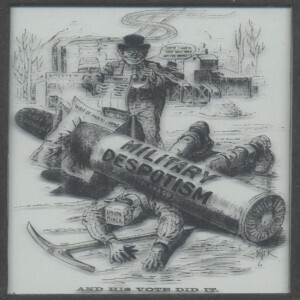
On this day in labor history, the year was 1894.
That was the day, gold miners in Cripple Creek, Colorado walked out on strike.
Mine owners increased the workday from 8 to 10 hours.
They refused to increase workers pay accordingly.
Workers immediately affiliated with the Western Federation of Miners. Local 19 leader, John Calderwood demanded a return to the 8-hour day at the previous wage, but the mine owners refused.
About 6 weeks into the strike, the larger gold mines imported scabs.
Violence soon followed.
The El Paso county sheriff demanded the governor call out the state militia.
But Colorado’s governor, Davis Waite was Populist. He recalled the troops upon learning they would be used as strike breakers.
Soon the mine owners raised their own private army of 100 troops, which grew to over 1200.
By May, miners armed themselves.
They took over a mine in Victor and blew it up when deputies arrived with scabs.
Governor Waite ordered the owners’ private army disbanded and called the militia out to defend strikers.
The mine owners agreed to return to the 8-hour workday at no loss in pay, but refused to disband their army.
They arrested and beat hundreds of miners.
The owners finally disbanded the forces when the governor threatened the militia’s presence in Victor for a month to keep the scab army immobilized.
It was the first and probably only time a state militia was called out in defense of striking workers.
According to Erik Loomis, “It was arguably organized labor’s biggest win in the Gilded Age.” Waite lost the next election.
But the victory meant enormous organizing gains for the WFM throughout the Rocky Mountain region.
More Episodes
 2024-07-18
2024-07-18
 2024-07-17
2024-07-17
 2024-07-16
2024-07-16
 2024-07-15
2024-07-15
 2024-07-14
2024-07-14
 2024-07-13
2024-07-13
 2024-07-12
2024-07-12
 2024-07-10
2024-07-10
 2024-07-09
2024-07-09
 2024-07-08
2024-07-08
 2024-07-06
2024-07-06
 2024-07-05
2024-07-05
 2024-07-03
2024-07-03
 2024-07-02
2024-07-02
 2024-07-01
2024-07-01
 2024-06-23
2024-06-23
Create your
podcast in
minutes
- Full-featured podcast site
- Unlimited storage and bandwidth
- Comprehensive podcast stats
- Distribute to Apple Podcasts, Spotify, and more
- Make money with your podcast
It is Free
- Privacy Policy
- Cookie Policy
- Terms of Use
- Consent Preferences
- Copyright © 2015-2024 Podbean.com




